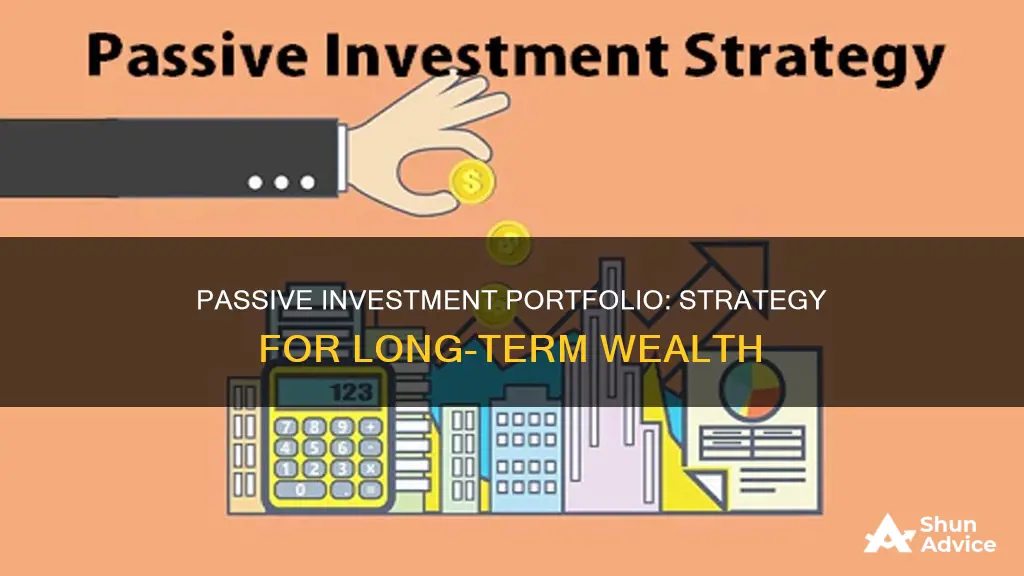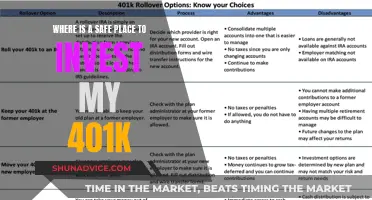
Passive investing is a long-term strategy for building wealth by buying securities that mirror stock market indexes and holding them for long periods. Passive investment portfolios are typically designed to parallel the returns of a particular market index or benchmark as closely as possible. This is done by investing in a mutual fund or exchange-traded fund (ETF) that mimics the index's holdings, either exactly or approximately. Passive investing is a more hands-off approach, where managers do not have to actively hunt for investments, minimising the costs of buying and selling securities.
Characteristics of a Passive Investment Portfolio
| Characteristics | Values |
|---|---|
| Investment Strategy | To maximize returns by minimizing the costs of buying and selling securities |
| Investment Holdings | A basket of assets that mirror stock market indexes |
| Investment Period | Long-term |
| Investment Risk | Lower risk due to investing in a mix of asset classes and industries |
| Investment Options | Limited investment options |
| Investment Returns | May not get above-market returns |
| Investment Management | Requires less management |
| Investment Costs | Lower fees |
| Investment Taxes | Lower capital gains taxes |
| Investment Performance | Steady returns |
What You'll Learn

Passive investing vs active investing
Passive investing is a long-term strategy for building wealth. It involves buying securities that mirror stock market indexes and holding them for the long term. Passive investing can be a good way to lower risk as it involves investing in a mix of asset classes and industries, rather than individual stocks. Passive investors tend to limit the amount of buying and selling within their portfolios, making this a very cost-effective way to invest.
On the other hand, active investing involves buying and selling investments based on their short-term performance, with the goal of beating the market's average returns. Active investors buy stocks or other investments regularly and sell those that are not performing well. Active investing takes a hands-on approach and requires a deeper analysis of investments and expertise in the market.
The type of investing you choose depends on your goals and risk tolerance. Passive investing may be a good option for those investing for the long term, such as in a retirement account, as it involves lower fees and less frequent buying and selling. It is also a good choice for those who want a more hands-off approach to investing.
Active investing, on the other hand, may be preferable for those who want more control over their investments and are willing to put in the time and effort to research and analyse individual stocks. Active investors have the advantage of being able to handpick their investments and make decisions based on market conditions.
Both passive and active investing have their strengths and weaknesses, and some investors choose to blend the two strategies to take advantage of the benefits of each. Ultimately, the decision of whether to invest passively or actively depends on an individual's financial goals, risk tolerance, and personal preferences.
Passive Investing Advantages:
- Ultra-low fees: Passive funds have lower fees because they don't involve stock picking and simply follow an index.
- Transparency: It is clear which assets are in a passive fund as they mirror a specific market index.
- Tax efficiency: The buy-and-hold strategy of passive investing typically results in lower capital gains taxes.
- Lower risk: Passive investing involves lower risk as it diversifies investments across a range of asset classes and industries.
Passive Investing Disadvantages:
- Limited investment options: Passive investors are limited to a specific index or set of investments and cannot deviate from those holdings, regardless of market conditions.
- Small returns: Passive funds rarely beat the market as they are designed to track it.
- Reliance on others: Passive investors rely on fund managers to make investment decisions and may not have a say in what they are invested in.
Active Investing Advantages:
- Flexibility: Active investors have the flexibility to buy any investment that meets their criteria and are not limited to a specific index.
- Hedging: Active managers can use strategies such as short sales and put options to hedge their bets and manage risk.
- Tax management: Active investing allows for tailored tax management strategies, such as selling losing investments to offset taxes on winning investments.
- Potential for high returns: Active investing aims to beat the market, so there is the potential for higher returns.
Active Investing Disadvantages:
- Expensive: Active investing involves higher fees due to the cost of research, analysis, and frequent trading.
- Active risk: Active managers are free to buy any investment they choose, which can lead to higher risk.
- Management risk: Fund managers are human and can make costly mistakes.
- Time-consuming: Active investing requires a hands-on approach and a deep analysis of investments, which can be time-consuming.
Savings and Investments: Strategies for Effective Money Allocation
You may want to see also

Lower fees and greater tax efficiency
Passive investing is a long-term strategy for building wealth by buying securities that mirror stock market indexes and holding them for long periods. Passive investment portfolios are typically designed to parallel the returns of a particular market index or benchmark as closely as possible.
Passive investment portfolios have lower fees and greater tax efficiency than actively managed portfolios. Firstly, passive investment portfolios do not require costly research, as they simply mirror a chosen market index. This means that passive investors do not have to pay the salaries of analyst teams that are required for active investment portfolios. Passive investment portfolios also do not require as much buying and selling, which can mean lower expense ratios.
Secondly, passive investment portfolios are more tax-efficient than active investment portfolios. This is because passive investment portfolios use a buy-and-hold strategy, which does not trigger large annual capital gains tax. In contrast, active investment portfolios trigger a capital gains tax every time shares are sold for a profit.
Overall, passive investment portfolios have much lower costs than active investment portfolios, which can result in greater returns over time.
Maximizing Your HSA Savings: Is Investing Right For You?
You may want to see also

Reduced risk
Passive investing is a long-term strategy for building wealth by buying securities that mirror stock market indexes and holding them for long periods. It is a passive strategy because it does not require investors to actively hunt for investments or time the market. Instead, they simply buy and sell the investments that their target benchmark trades.
Passive investing can lower risk for investors in several ways:
Broad Diversification
Passive investing typically involves investing in a broad range of asset classes and industries, rather than relying on the performance of individual stocks. This diversification helps to reduce risk by spreading it across a wider range of investments. If one asset in the portfolio performs poorly, it is likely that other assets will continue to perform well, thus reducing the overall risk.
Lower Fees and Costs
Passive investing often involves lower fees and costs compared to active investing. Passive investment funds tend to be less expensive to operate because they do not require costly research and analysis to identify individual stocks to invest in. Instead, they simply mirror the holdings of a particular stock market index. Lower fees and costs can lead to higher overall returns, even if the individual returns on each investment are lower.
Tax Efficiency
Passive investing is often more tax-efficient than active investing because it involves holding assets for the long term, which results in lower capital gains taxes. Active investing, on the other hand, involves frequent buying and selling of assets, which can trigger higher capital gains taxes.
Reduced Volatility
Passive investing seeks to replicate the performance of the overall stock market, which has historically posted positive returns over time. This strategy avoids the short-term volatility and risks associated with trying to time the market or beat the market. By focusing on long-term returns, passive investing can reduce the risk of short-term losses.
Simplicity and Transparency
Passive investing is generally simpler and easier to understand than active investing. It does not require the same level of research, analysis, and decision-making as active investing. The holdings of passive investment funds are also more transparent, as they simply mirror the holdings of a particular stock market index. This transparency can help investors better understand the risks and potential returns of their investments.
Savings and Investment: Interplay in a Closed Economy
You may want to see also

Lack of flexibility
Passive investing is a long-term strategy for building wealth by buying securities that mirror stock market indexes and holding them for a long time. Passive investment portfolios are typically designed to parallel the returns of a particular market index or benchmark as closely as possible.
One of the drawbacks of passive investment portfolios is their lack of flexibility. Passive funds are limited to a specific index or a predetermined set of investments. They are usually allowed to make very few changes, if any, to their holdings. This means that investors are locked into those holdings, regardless of what happens in the market.
Index fund managers, for example, are typically prohibited from using defensive measures such as reducing their position in shares of particular securities, even if they believe those share prices will decline. This lack of flexibility can be a disadvantage when market conditions change or when the manager identifies opportunities to improve the performance of the portfolio.
Additionally, passively managed index funds face performance constraints. They are designed to provide returns that closely track their benchmark index, rather than outperforming it. They rarely beat the return on the index and usually return slightly less due to operating costs.
The passive investment approach prioritises minimising costs and risks over the potential for higher returns. It is a strategy that aims to generate returns that are in line with the market average, rather than seeking to outperform the market. This means that passive investors may miss out on opportunities to generate above-market returns, especially during times of market volatility when active investors can take advantage of short-term price fluctuations.
In summary, the lack of flexibility in passive investment portfolios can be a trade-off for the benefits of lower fees, simplicity, and reduced risks associated with this investment approach.
Savings, Investment, and Outflow: Understanding the Balance
You may want to see also

Superior after-tax results
Passive investing is a long-term strategy for building wealth by buying securities that mirror stock market indexes and holding them for long periods. Passive investment portfolios are typically designed to parallel the returns of a particular market index or benchmark as closely as possible.
Passive investment portfolios have lower fees and greater tax efficiency than active investment portfolios. Passive investment portfolios are also simpler and less risky than active investment portfolios. These factors contribute to superior after-tax results for passive investment portfolios over medium to long time horizons.
Firstly, passive investment portfolios have lower fees than active investment portfolios. Passive investment portfolios do not require costly research, as they simply buy and sell the investments that their target benchmark trades. In contrast, active investors must research and decide which securities to own, which triggers transaction costs and higher salaries for analyst teams. These higher fees can hamper returns over time.
Secondly, passive investment portfolios have greater tax efficiency than active investment portfolios. Passive investment portfolios that use a buy-and-hold strategy typically generate low or no taxable capital gains annually for shareholders. In contrast, active investment portfolios that frequently buy and sell securities can trigger a capital gains tax.
Thirdly, passive investment portfolios are simpler than active investment portfolios. Owning an index or group of indices is far easier to implement and understand than a dynamic strategy that requires constant research and adjustment.
Finally, passive investment portfolios are less risky than active investment portfolios. Passive investment portfolios seek to build wealth gradually by avoiding frequent trading, which reduces costs in the form of transaction fees, commissions, and taxable capital gains. Passive investment portfolios also reduce the time and effort it takes to decide which securities to buy and sell, as they track a target benchmark or index rather than seeking isolated individual winners.
In summary, passive investment portfolios have lower fees, greater tax efficiency, simplicity, and reduced risk compared to active investment portfolios. These factors contribute to superior after-tax results for passive investment portfolios over medium to long time horizons.
Building an Investment Portfolio: A College Graduate's Guide
You may want to see also
Frequently asked questions
A passive investment portfolio is a long-term strategy for building wealth by buying securities that mirror stock market indexes and holding them for a long time. Passive investment portfolios aim to minimise the costs of buying and selling securities.
Passive investment portfolios are less expensive and complex than active management. They also often produce superior after-tax results over medium to long time horizons. Passive investment portfolios are also more transparent and tax-efficient than active management.
Passive investment portfolios may not get above-market returns as they aim to match the market average. They also have limited investment options as investors cannot handpick each investment.
You can pursue a passive investment strategy by buying shares in either index mutual funds or index exchange-traded funds (ETFs).







